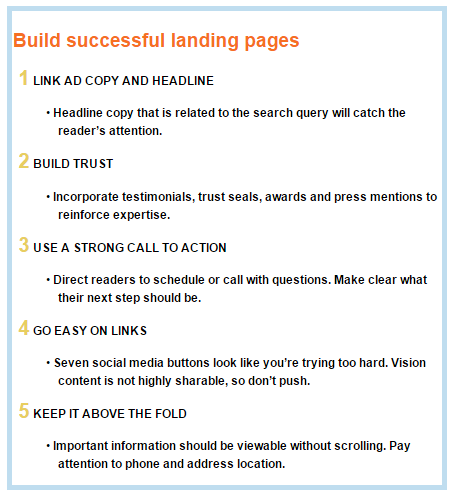 In an earlier article, I discussed how to monitor web visitors: who is visiting, where they live, and how to tighten viewership radius. Now, let me share what we know about viewership of ophthalmology websites, and how you can best structure practice information on your site to maximize scheduling.
In an earlier article, I discussed how to monitor web visitors: who is visiting, where they live, and how to tighten viewership radius. Now, let me share what we know about viewership of ophthalmology websites, and how you can best structure practice information on your site to maximize scheduling.
Would it surprise you to learn:
• 85% of web visitors enter from landing pages, not the home page
• 54% of people who enter through the home page look no further
• The average visitor only ooks at 1.6 pages of the site
• Visitors give you 48 seconds of their time
• For every form submitted online, you’ll receive six phone calls
If you’re marketing your practice using pay-per-click (PPC) advertising on Google, Bing, Yahoo, Facebook, YouTube, et al., then you should be using landing pages. Landing pages are constructed to answer individual search queries, for example “Symptoms of a cataract?” If someone types this question, they will see organic and paid search results for cataract symptoms, as determined by search engine algorithms. You may have a page on your website, titled “Cataract Symptoms” that receives high placement in organic search results.
But you may also bid on the search term “Cataract Symptoms” in PPC advertising, to ensure that potential patients consider your practice.
However, many of you will send this person, when they click the link or ad, to your home page. At that moment, you’ve lost their trust and interest. Why? Because the answer to “Cataract Symptoms” wasn’t on your home page. Your website visitors are going to be reluctant to search any further.
How many steps a purchaser is willing to make to complete a transaction is an issue of some debate in the online community. Our own experience in ophthalmology says prospects will take four steps:
Anything more than this sequence results in lost conversion. So you must develop web pages that directly answer search queries. This technique means rewriting web pages from general topic areas, to specific answers to the most common searches. Each page should then quickly direct that user to pick up the phone or submit a form to schedule an appointment.
In our experience, 85% of visitors enter through landing pages. Only 15% come to your website home page. Landing pages that allow visitors to take all necessary action to contact the practice are extremely valuable in today’s search-oriented world.
 Your practice home page is primarily viewed for two reasons: to find a phone number and driving directions.
Your practice home page is primarily viewed for two reasons: to find a phone number and driving directions.
Take a look at your home page on a desktop computer, a tablet and a smartphone. Can people find a phone number immediately? Is your address immediately apparent? Are both viewable without scrolling? Is the font large enough and presented in high-contrast for prospects who might have compromised vision? Is the phone number clickable? Can driving directions be printed with one click? Improve conversion by improving access and relevance on your web pages.